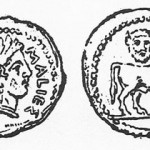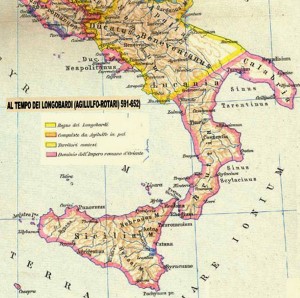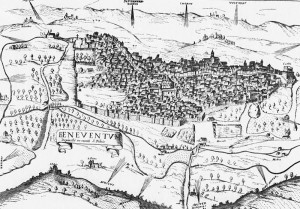 Benevento goes back to antiquity. According to a legend, it was founded by the Greek hero Diomedes, who landed in Italy after the destruction of Troy. He would have given to the city a defense of the mythical Calydon boar killed by his uncle Meleager. The boar remained the symbol of Benevento.
Benevento goes back to antiquity. According to a legend, it was founded by the Greek hero Diomedes, who landed in Italy after the destruction of Troy. He would have given to the city a defense of the mythical Calydon boar killed by his uncle Meleager. The boar remained the symbol of Benevento.
A coin of the fourth century BC, would indicate that the city was called Malies, which led to the name of Maloenton, Greek name meaning herd of sheep or goats, which the Samnites practiced breeding.
However, the foundation is probably the fact of the Osque people, before a settlement of the Samnites.
The romans
In 314 BC, the name of Maleventum appeared for the first time in the first Samnite war against the tribes of the Sannio region dominated by the Samnite tribe of hirpins. This war ended with the conquest of Latium by the Romans.
During the second Samnite war from 327 to 304 BC, the Romans suffered a severe defeat, with their humiliation at Caudine Forks.
Subsequently, the strengthened Samnites pushed the other peoples of the center and south of the peninsula (especially Etruscans) to rise up against the Romans.
However, from – 298 to – 290, the Romans defeated each of the Samnite allies to whom they imposed a treaty in -290.
Maleventum was occupied by the Romans, besides the city was the theater of the victory against Pyrrhus, the king of Epirus in – 275 and its allies (Greek, Tarentains and Samnites)
It is certain that in – 268, the city renamed Beneventum was a Roman colony, its old name being associated with bad luck.
The area was the scene of battles during the Second Punic War against Carthage, which saw the defeat of the Carthaginian general Hannon in -214 and -210.
Became Roman municipality in 86 BC, Benevento is towards the end of the republic described as one of the most prosperous cities of the south of the peninsula.
Its growth continued under the empire, with the construction of Via Traiana, a variant of the Appian Way from Benevento. In the fourth century, the city was after Capua the most populous of the south.
Middle Ages: the duchy
Became a bishopric in the fourth and fifth centuries, Beneventum suffered a terrible earthquake in 369, and it declined at the same time as the Roman Empire.
In 410, the Visigoths seize it, then the Vandals in 455. The Western Roman Empire collapsed and the Goths seized it in 490. It was liberated by the Byzantines of Belisarius in 536, then conquered and ravaged in 545 by Totila, King of the Ostrogoths of Italy.
 In 571, the Longobards founded the Duchy of Benevento, whose first duke was Zotton, and the last Arigis II, until 787.
In 571, the Longobards founded the Duchy of Benevento, whose first duke was Zotton, and the last Arigis II, until 787.
Relatively isolated, the duchy remained unscathed during the conquest of the Franks of Charlemagne. The fall of the Longobard kingdom of Pavia in 774, in the north, caused Arigis II to seize the Lombard crown, but the Franks did not hear it that way. Given the scale of his project, Arigis II contended to erect the duchy in the principality, the Franks besieged Salerno in 784, Arigis II surrendered and formally became vassal of Charlemagne.
In the eighth century, the duchy extended over much of the south of the peninsula, excluding Naples and Calabria, including Capua and Salerno.
The son of the former Longobard king Didier, Adalgis, who had taken refuge in Constantinople, invaded the duchy with the help of the Byzantines. He was nevertheless rejected.
In 840 the Prince Sicard is assassinated, there followed a palace war for his succession, the estate was divided into two principalities: Benevento headed by Radalgis, who was the supposed assassin of Sicard, and Salerno led by Siconulf, brother of Sicard (principality roughly corresponding to half of the Tyrrhenian sea side). The chaos intensified, some counties like Capua declared themselves independent. Radalgis and Siconulf hired Saracen mercenaries. This did not help the overall situation, with an emancipation of the latter who established a colony in southern Lazio (they were dislodged in 915 by a Christian League at the Battle of Garigliano). At the same time, the Byzantines took the opportunity to disembark and recapture Apulia.
In 978, Pandulf Ironhead once again reunited Benevento, Capua and Salerno, until his succession … sharing the territory between his sons.
At the beginning of the 11th, Benevento declined. In 1022, the German emperor Henry II took it temporarily.
The arrival of the Normans, first mercenaries who came to fight the Saracens, then the battles in Italy between Lombardy longobards, Byzantines of Apulia and Saracens of Calabria turned to the advantage of the Norman who cleaned all that erected their own duchy in Apulia, with Melfi for capital.
In 1053, the Battle of Civitate saw the Normans led by Robert the Guiscard defeat a coalition of the Pope, the Longobards and the German Emperor. It was the end of the Principality of Benevento which became a city without territorial power, however held by the papacy.
For centuries, this enclave of the Popes in the Kingdom of Naples was ruled by the pontifical rectors, notwithstanding various “vicissitudes”.
The emperor and the Swabians dominated the Kingdom of Sicily from the end of the 12th century. The troops of Frederick II, opposed to the Pope, seized and pillaged Beneventum in 1241.
In 1266, Manfred of Swabia, King of Sicily, was defeated and killed in the battle of Benevento against Charles I of Anjou, sent by the Pope and to whom he entrusted the crown of the Kingdom of the Two Sicilies.
For almost two centuries the city remained “more or less” administered by papal rectors, the population having rebelled several times against clerics.
In the succession struggles between Angevins and Aragonese, Pope Eugene IV ceded liberties to the city.
Modern and contemporary era
Nevertheless, the Aragonese removed from the Kingdom the Angevins who had the support of the Pope. They asserted their dominion over the city, especially with the King Ferrante of Naples who occupied Benevento, after Pope Calixtus III appointed as governor his nephew Peter-Ludovic Borgia.
The city was returned to the Pope’s delegate in 1459 against the recognition of Ferrante as King of the Kingdom.
But Beneventum became the scene of struggles between pro and anti-Pope factions until they signed peace in 1525.
In 1528, the city was occupied and emptied of its resources by the troops of Charles V of Hasbourg, but the appointment in 1530 of Ferdinand I Gonzaga like governor augured a more prosperous period.
The papacy regained its influence, moreover Pius V emitted a papal bull to expel the Jews from the Papal States (including Benevento), except Rome and Ancona. In May 1617, the city council voted to send a petition for the return of the Jews, which seems to have remained without return.
In the seventeenth century, the plagues of 1630 and 1656 and famine impoverished the city.
In 1688, Benevento was destroyed by an earthquake. But his cardinal Archbishop Orsini, the future Benedict XIII, rebuilt the city and developed the economy.
Occupied by the bourbons of the King of Naples Ferdinand IV during the invasion of the Napoleonic troops, it was ceded to the French.
But in 1799, a popular revolt freed it and it joined the Partenopean Republic of Naples. Napoleon seized it again and later made it the seat of a new principality which he entrusted to Talleyrand in 1806.
At the restoration in 1815 and the Congress of Vienna, it returned to church until 1860, during the reunification of Italy in a new Kingdom.
In 1967, Benevento was decorated for the bravery of its inhabitants during the tragic Anglo-American bombings of 1943. They did in fact nearly 2000 civilian deaths, and 5000 homes razed.
Learn more :


